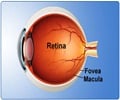New links between a common form of inherited blindness affecting children and a gene known as Abelson helper integration site-1 (AHI1) have been found in a new study led by scientists at the University of California, San Diego School of Medicine.
The findings may help in the development of new therapies and improved techniques for diagnosing the retinal disease.A newly recognized class of disorder known as "ciliopathies" has gripped the medical community. Ciliopathies are caused by problems in the structure and/or function of cilia, which are small antenna-like structures protruding from cells' surface.
Ciliopathies patients may suffer from problems like retinal blindness, obesity, renal failure, liver fibrosis and mental impairment.
Findings in the past few years have related many forms of these diseases with defects in the structure or signalling capacity of the cilia in cells as diverse as retinal, fat, kidney, liver and nerve cells.
Since cilia are so widely present on cells throughout the body, many diseases that look unrelated are now known to be linked through functions of cilia.
Joseph G. Gleeson, professor of neurosciences and pediatrics at UC San Diego and Howard Hughes Medical Institute Investigator, under whose supervision the research was conducted, said: "We are just beginning to uncover the genetic causes for these disorders, but more research is needed to understand why patients with these particular genetic alterations have such variable diseases,"
Advertisement
The model was similar to the most common form of inherited blindness, which is due to degeneration of the retina at an early age.
Advertisement
Gleeson believes this finding sheds light on one of the potential causes of retinal degeneration, protein mis-trafficking, which has been of primary interest in the study of inherited blindness.
Thereafter, the group tested whether mutations in genes might lead to to retinal blindness in other related diseases.
Their study of a group of European patients suggests that this is the case.
The scientists discovered that patients carrying a particular genetic alteration were between five and ten times more prone to have retinal blindness, and that some forms of this blindness may be particularly accepting to gene therapy.
Louie said: "These results may lead to better screening and future therapies for congenital blindness...As routine sequencing of the human genome becomes more and more feasible, studies like ours will help pinpoint which genetic alterations increase the risk of having a certain disease, or the likelihood that your children will have the disease."
The study will appear in journal Nature Genetics.
Source-ANI
RAS










